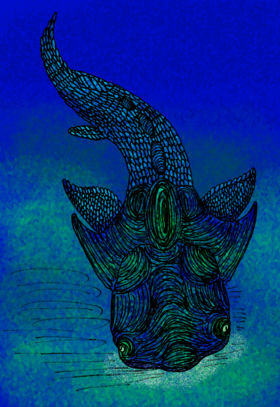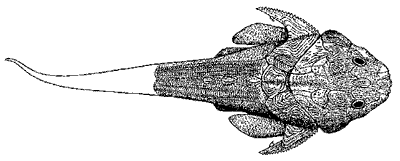
| Palaeos: |  |
Placodermi |
| The Vertebrates | Petalichthyida |
| Page Back | Unit Home | Unit Dendrogram | Unit References | Taxon Index | Page Next |
| Unit Back | Vertebrates Home | Vertebrate Dendrograms | Vertebrate References | Glossary | Unit Next |
|
Abbreviated Dendrogram
Gnathostomata | `--Acanthodii etc (if traditional placement) | Placodermi |?==Acanthothoraci |--Rhenanida `--+--Antiarchi `--+--+--Petalichthyida | `--Ptyctodontida `--+--Arthrodira `==Acanthodii |--Chondrichthyes `--Osteichthyes |
Contents
Overview |
 The petalichthyid placoderm, Quasipetalichthys haikouensis of Early Devonian China.. © Stanton F. Fink |
The Petalichthyida was an order of small, flattened placoderm fish. They were typified by their splayed fins, and numerous tubercles that decorated all of the plates and scales of their armor. They reached a peak in diversity during the Early Devonian and were found throughout the world, particularly in Europe (especially in Germany), North America, Asia, South America, and Australia. The petalichthids Lunaspis and Wijdeaspis are among the best known. There was an independant diversification event that occured in what is now Southern China, producing a handful of unique genera that were once placed in their own order, "Quasipetalichthyida," named after the first discovered (and described) species there, Quasipetalichthys haikouensis. Soon after the Petalichthids' diversification, they went into a decline, until the last few species were exterminated along with the rest of the placoderms during the Late Devonian extinction event.
Some experts view the differences between the quasipetalichthyids and the petalichthyids proper in the joint articulation of the skull and thoracic plates to be proof that Petalichthyida is paraphyletic, and that the skull to thorax articulation of quasipetalichthyids is actually more similar to arthrodires. However, this hypothesis is not widely accepted, as there needs to be more studies done on fossil specimens.
From what can be garnered from their compressed body forms, it is presumed that the Petalichthyids were bottom-dwellers that either chased after, swam after, or ambushed smaller fish. However, their diet is highly speculatory, as none of the fossil specimens found have the mouth or mouth parts preserved.
The armor of the Petalichthyids are very distinctive, being decorated by a series of grooved "finger-print" patterns on the outer surface of the plates, very smiliar to the patterns of the Phyllolepida. It is strongly suspected that the grooves either held nerves, or created extra surface area for motion- and or electrochemically sensitive organs in the skin. Stanton060924
 |
| Lunaspis. Lochkovian to Emsian (Early Devonian), widespread: (southeast Euramerica, southeast Gondwana, China). Length 20 cm. |
Range: Early Devonian of Europe, China & Australia
Phylogeny: Placodermi::: Ptyctodontida + *.
Characters: Like primitive Arthrodira. Dorsoventrally compressed; orbits face dorsally; widely splayed pectoral fins, with cornua common; no post-pectoral plates; plates ornamented with linear rows of tubercles; strictly benthonic?
Links: Macropetalichthyidae; Placodermi, (Klass Gnathostoma). ATW030320.
| Page Back | Unit Home | Page Top | Page Next |
checked ATW0151003; new page MAK111024